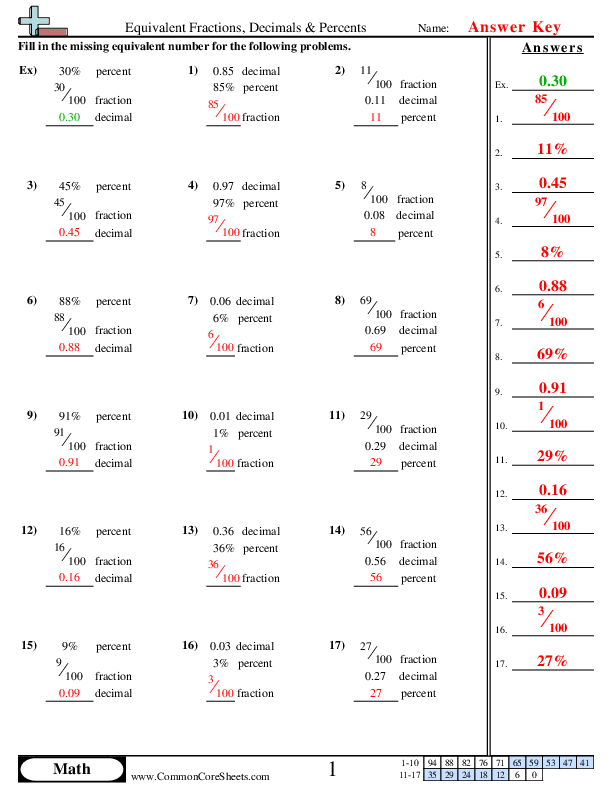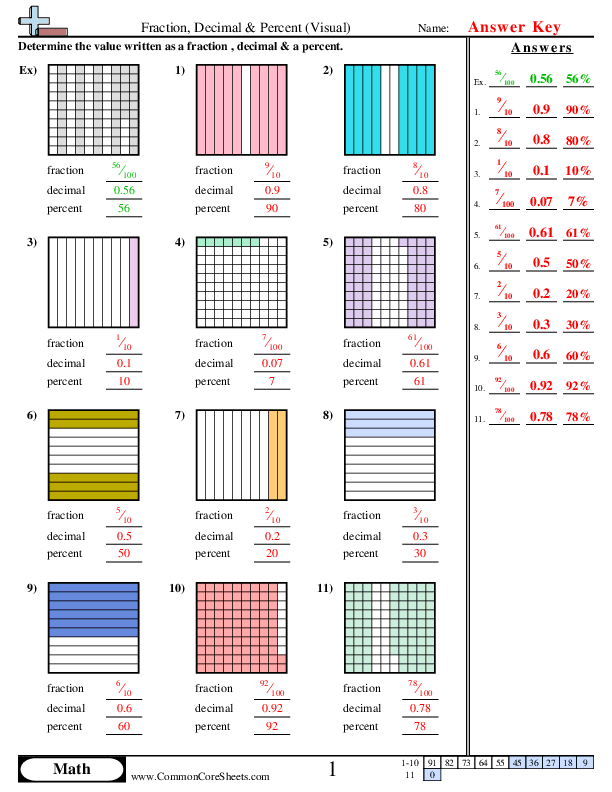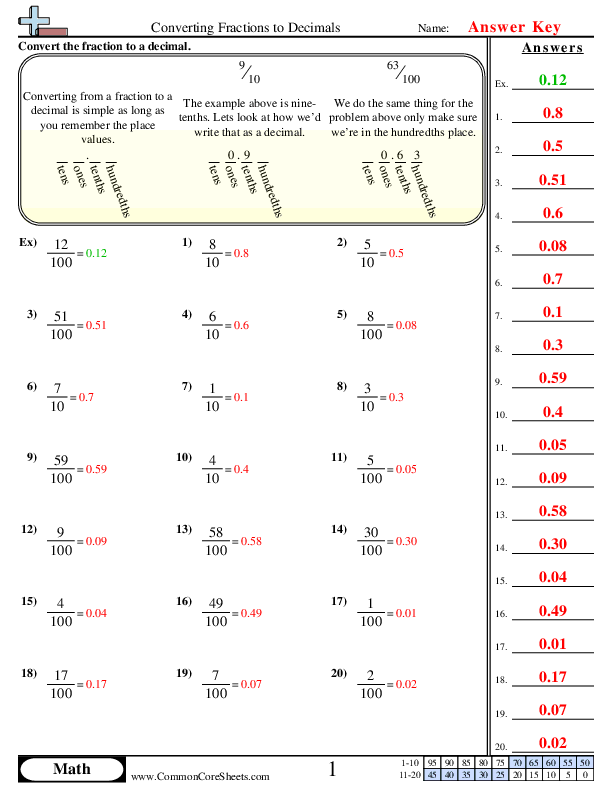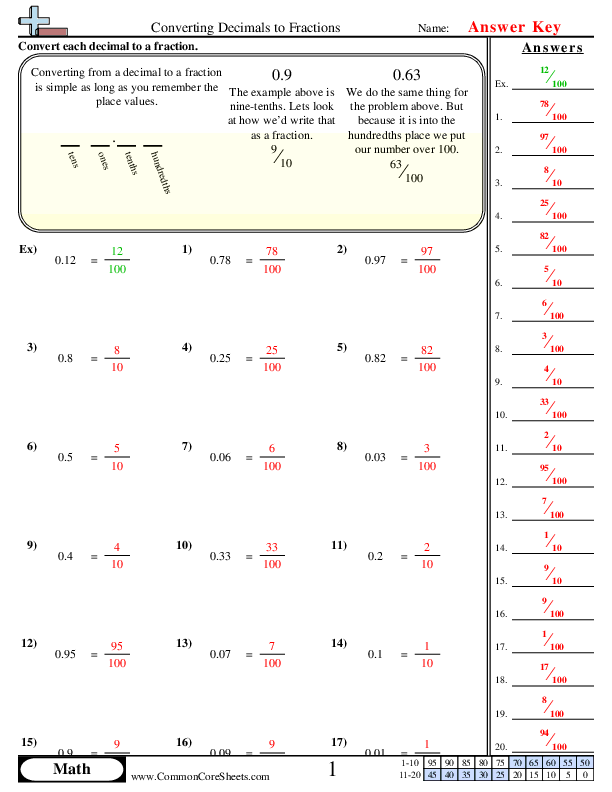Our fraction worksheets are the best on the internet! These free worksheets are perfect for students of all ages who are learning or reviewing fractions. Our fraction worksheets cover a range of skills, from simplifying fractions to adding and subtracting fractions with different denominators. Each worksheet includes clear instructions and plenty of space for students to show their work. With our fraction worksheets, you'll find everything you need to help your students master this important math concept. So why wait? Try our fraction worksheets today and see why they're the best on the internet!
Browse Sheets By Problem Type
×
Comparing Fractions, Decimals & Percents

Comparing Fractions (Numeric)
4nf6


×
Description:
"This worksheet is designed to reinforce children's understanding of comparing fractions. With a series of 20 customisable problems, it provides interactive numeric exercises to identify which fraction is greater or lesser. Ideal for distance learning, this dynamic tool can also be converted into flash cards, proving invaluable for mastering the vital math skill of fraction comparison."

×
Student Goals:
Understanding of FractionsAfter completing this worksheet, students should have a firm understanding of fractions. They will be able to identify numbers represented as fractions and interpret the value represented by each fraction. This is crucial because understanding of fractions is foundational in many mathematical and real-world contexts.Comparative SkillsStudents will develop their comparative skills by determining the relative value of two fractions. They will be adept at telling if a fraction is greater, less, or equal to another, aiding in decision making, problem-solving and cognitive development.Fraction NormalizationStudents will be able to normalize fractions to ensure they are in their simplest form. This will enhance students' fractions comprehension and provides a solid basis for advancing to more complex fraction problems.Mathematical ConfidenceAfter successfully completing the worksheet, students should be more confident in their mathematical abilities. Having gained some proficiency in one of the core concepts in mathematics, they would perceive math problems not as challenges but rather situations they can handle.Practical Mathematical ApplicationIt instills in students the realization that math can be applied practically to solve real-world problems. Comparing fractions is an essential skill in many situations including cooking, construction, and financial management.Numerical FluencyBy consistently practicing and resolving the problems, pupils will enhance their numerical fluency, or the ability to manipulate numbers and mathematical expressions comfortably. Increased numerical fluency leads to better comprehension of more advanced mathematical concepts.Enhancement of Cognitive AbilitiesThe process of comparing fractions requires a high level of cognitive function, including analysis and critical thinking. By working through the problems on this worksheet, students will enhance their cognitive abilities, which have widespread benefits across many aspects of life.



Fractions, Decimals & Percents (Numeric)
4nf6


×
Description:
"This worksheet is designed to aid in understanding the relation between fractions, decimals, and percentages. With 17 problems, it gives children hands-on practice in converting between these equivalent forms of numbers. Highly customizable, the worksheet can be adapted to fit different learners' needs, successfully converted into flashcards, or seamlessly integrated into distance learning curricula, providing an engaging tool to enhance math proficiency."

×
Student Goals:
Master the concept of equivalent fractions, decimals and percentagesAfter completing this worksheet, students should have a thorough understanding of the concept of equivalency among fractions, decimals, and percentages. They should be able to seamlessly convert a value from one form to another, showing a solid understanding of the integral relationships between these three mathematical representations.Develop computational skillsThis practice will foster students' computational skills, necessary for more advanced mathematical procedures. They would be well-versed with calculations involving the transition from fractions to decimals to percentages and vice-versa, enhancing their ability to calculate quickly and accurately.Promote problem-solving abilityBy working through the problems in this worksheet, students will improve their problem-solving skills. They will learn how to approach and solve complex problems involving fractions, decimals, and percentages. This practice will encourage critical thinking and logical reasoning, fundamental skills that are used in everyday life and other academic subjects.Amplify number senseCompletion of this worksheet will enhance students' number sense. It would promote a deeper understanding of the nature of numbers and their relationships, particularly in the context of fractions, percentages, and decimal values. This translates into improved mathematical intuition and a swift sense for number manipulation.Improve precision and attention to detailHandling fractions, decimals, and percents would help students fine-tune their precision and heighten their attentiveness to detail. As comprehension of these topics demands meticulous calculation and exactness, students will strengthen these qualities through consistent practice.Boost confidence in mathSuccessfully completing this worksheet means not only understanding the relationship between fractions, decimals, and percentages but also being adept at manipulating them. This mastery can result in greater confidence while facing math problems, which can in turn encourage a positive mindset towards learning new mathematical concepts.



Fraction, Decimal and Percent (Visual)
4nf6


×
Description:
"This worksheet is designed to enhance children's understanding of the correlation between fractions, decimals, and percentages using clear visual aids. It offers 11 unique problems, enabling students to apply their learned concepts practically. Educators can customize this versatile resource, creating flashcards for a more interactive experience or integrating it into distance learning curricula. This focused approach aids in building a solid foundation for more complex mathematical concepts."

×
Student Goals:
Understanding of Basic Mathematical RepresentationStudents should demonstrate a solid grasp of basic mathematical representation by successfully completing each problem in the worksheet. This includes understanding fractions, decimals, and percentages, and their relations. They should be able to confidently convert fractions to decimals and percentages, and vice versa, thus displaying proficiency in manipulating different mathematical forms.Mathematical Literacy DevelopmentBy the completion of the worksheet, students should have improved their mathematical literacy. They're set to have deepened their understanding of mathematical concepts and terminology, especially those pertaining to fractions, decimals, and percentages. A boosted level of mathematical literacy will make them better at quickly recognizing and processing mathematical patterns, which is a key skill that will benefit them in future advanced mathematical endeavors.Analytical Skills EnhancementAfter engaging with the worksheet, students are expected to have enhanced their analytical skills. By navigating from fractions to decimals to percentages, and correlating their common value, students will have strengthened their analytical thinking. This is a critical skill not just in mathematics but in problem-solving in other academic spheres and real-life situations. It helps develop an independent thinking process that is essential to make them successful learners.Comprehension of Practical ApplicationsUpon completion, students are projected to appreciate the practical applications of what they have learnt. Fractions, decimals, and percentages are not just theoretical mathematical concepts; they come to life in many everyday scenarios. Whether it's managing personal finances, planning baking recipes, or analyzing sports statistics, these concepts are widely used. Understanding them can thus empower students to navigate their everyday life more effectively.Confidence in Mathematical AbilitiesFinally, students should gain enhanced confidence in their mathematical abilities. Successfully solving these exercises will give them a strong sense of achievement and boost their academic confidence. This belief in their own capabilities will motivate them to approach more challenging mathematical problems in the future with less fear and more determination. In learning, confidence is key, and through mastering this worksheet, students are setting up a positive foundation for all future learning.



Converting Fractions to Decimals (10ths & 100ths)
4nf6


×
Description:
"This worksheet is designed to help children master the concept of converting fractions to decimals in a fun, engaging way. It offers 20 math problems where kids convert typical fractions into their decimal equivalents. Its interactive format offers adaptability and can be customized to suit individual learning needs. It could even be transformed into flash cards for additional practice or used in a distance learning environment to ensure continuous and effective learning."

×
Student Goals:
Understanding Fractions and DecimalsAfter completing the worksheet, students will have a clear understanding of how fractions and decimals are related. They will be able to effortlessly convert fractions to decimals and will know the underlying process behind it. This fundamental knowledge will allow them to navigate more complex math problems with ease.Mastery of Arithmetic SkillsBy practicing with twenty problems, students will achieve mastery in the arithmetic required to convert fractions into decimals. Their computation skills, coupled with an understanding of the place-value system used in decimals, will be significantly improved, enhancing their overall mathematical capabilities.Improved Problem-Solving SkillsThis worksheet is designed to foster mathematical inquiry, encouraging students to independently solve problems. After successful completion, they will have improved their problem-solving skills, which can be applied to other math topics and real-world scenarios.Boost in Mathematical ConfidenceBy successfully converting fractions to decimals, students will experience a significant boost in confidence, making them more likely to engage with mathematical topics in the future. This essential trust in their abilities can contribute positively to their overall academic performance.Preparation for Advanced Mathematical ConceptsThe knowledge of converting fractions to decimals is an integral part of more advanced mathematical concepts like algebra, percentage calculations, and data interpretation. Therefore, after completing the worksheet, students will be well-prepared for tackling these advanced topics when they encounter them.Enhancement of Analytical SkillsThe process of converting fractions to decimals involves step-by-step logical reasoning. As students navigate through these steps, they enhance their analytical skills — a trait that’s not only important in mathematics, but also beneficial in other subject areas and in everyday life.



Converting Decimals to Fractions (10ths & 100ths)
4nf6


×
Description:
"This worksheet is designed to instruct students on the subject of mathematics, specifically converting decimals to fractions. With 20 problems that visualize decimal values equaling to fractions, it provides engaging examples and practical exercises. Flexible for any learning environment, this worksheet is customizable, can be effortlessly converted into flash cards, and is suitable for distance learning, making it an adaptable educational resource."

×
Student Goals:
Understanding of Decimals and FractionsAfter completing the worksheet, students will have a firm understanding of decimals and their corresponding fractions. They should grasp the important concept that fractions and decimals are just two different ways of expressing the same value. This understanding provides a strong foundation for more advanced mathematical concepts.Conversion SkillsThe completion of the worksheet will equip learners with the necessary skills to convert decimals into fractions effortlessly. They will understand the systematic process involved in transforming a decimal into both its reduced and non-reduced fraction forms. This skill is central to many aspects of mathematics and is crucial for subsequent learning stages.Enhanced Problem-Solving AbilitiesWorking through the problems on this worksheet requires logical reasoning and problem-solving skills. The students will be better at diagnosing the problem, understanding the steps it takes to solve it, and applying this approach to different, yet similar problems. These enhanced abilities extend well beyond mathematics and are beneficial to all other subjects.Confidence in MathematicsSuccessfully converting decimals to fractions can boost the confidence of the learners. Building assurance in their mathematical abilities will encourage them to tackle more challenging problems without fear of failure. This confidence is pivotal in stimulating a positive attitude towards mathematics and other numeracy-based subjects.Preparation for Advanced MaterialThe ability to convert decimals to fractions is important in higher mathematical contexts such as algebra, geometry, and calculus. By honing these skills now, students will be better prepared to manage future mathematical coursework. This worksheet sets the groundwork for these critical, more advanced mathematical concepts.Real-World ApplicationThe ability to convert decimals to fractions has many practical, real-world applications, including but not limited to understanding scientific data, making accurate financial decisions, or even dividing recipes in cooking. By mastering this skill, students will be able to handle numbers in various real-life situations more efficiently.






